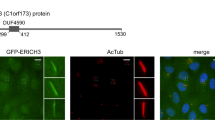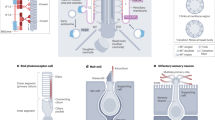Abstract
Hedgehog (Hh) signalling is essential for several aspects of embryogenesis1,2. In Drosophila, Hh transduction is mediated by a cytoplasmic signalling complex3,4,5 that includes the putative serine-threonine kinase Fused (Fu) and the kinesin Costal 2 (Cos2, also known as Cos), yet Fu does not have a conserved role in Hh signalling in mammals6,7. Mouse Fu (also known as Stk36) mutants are viable and seem to respond normally to Hh signalling. Here we show that mouse Fu is essential for construction of the central pair apparatus of motile, 9+2 cilia and offers a new model of human primary ciliary dyskinesia. We found that mouse Fu physically interacts with Kif27, a mammalian Cos2 orthologue8, and linked Fu to known structural components of the central pair apparatus, providing evidence for the first regulatory component involved in central pair construction. We also demonstrated that zebrafish Fu is required both for Hh signalling and cilia biogenesis in Kupffer’s vesicle. Mouse Fu rescued both Hh-dependent and -independent defects in zebrafish. Our results delineate a new pathway for central pair apparatus assembly, identify common regulators of Hh signalling and motile ciliogenesis, and provide insights into the evolution of the Hh cascade.
This is a preview of subscription content, access via your institution
Access options
Subscribe to this journal
Receive 51 print issues and online access
$199.00 per year
only $3.90 per issue
Buy this article
- Purchase on Springer Link
- Instant access to full article PDF
Prices may be subject to local taxes which are calculated during checkout




Similar content being viewed by others
References
McMahon, A. P., Ingham, P. W. & Tabin, C. J. Developmental roles and clinical significance of hedgehog signaling. Curr. Top. Dev. Biol. 53, 1–114 (2003)
Huangfu, D. & Anderson, K. V. Signaling from Smo to Ci/Gli: conservation and divergence of Hedgehog pathways from Drosophila to vertebrates. Development 133, 3–14 (2006)
Sisson, J. C., Ho, K. S., Suyama, K. & Scott, M. P. Costal2, a novel kinesin-related protein in the Hedgehog signaling pathway. Cell 90, 235–245 (1997)
Robbins, D. J. et al. Hedgehog elicits signal transduction by means of a large complex containing the kinesin-related protein costal2. Cell 90, 225–234 (1997)
Lum, L. et al. Hedgehog signal transduction via Smoothened association with a cytoplasmic complex scaffolded by the atypical kinesin, Costal-2. Mol. Cell 12, 1261–1274 (2003)
Chen, M. H., Gao, N., Kawakami, T. & Chuang, P. T. Mice deficient in the fused homolog do not exhibit phenotypes indicative of perturbed hedgehog signaling during embryonic development. Mol. Cell. Biol. 25, 7042–7053 (2005)
Merchant, M. et al. Loss of the serine/threonine kinase fused results in postnatal growth defects and lethality due to progressive hydrocephalus. Mol. Cell. Biol. 25, 7054–7068 (2005)
Katoh, Y. & Katoh, M. KIF27 is one of orthologs for Drosophila Costal-2. Int. J. Oncol. 25, 1875–1880 (2004)
Davenport, J. R. & Yoder, B. K. An incredible decade for the primary cilium: a look at a once-forgotten organelle. Am. J. Physiol. Renal Physiol. 289, F1159–F1169 (2005)
Davis, E. E., Brueckner, M. & Katsanis, N. The emerging complexity of the vertebrate cilium: new functional roles for an ancient organelle. Dev. Cell 11, 9–19 (2006)
Afzelius, B. A. Cilia-related diseases. J. Pathol. 204, 470–477 (2004)
Marshall, W. F. & Kintner, C. Cilia orientation and the fluid mechanics of development. Curr. Opin. Cell Biol. 20, 48–52 (2008)
Zariwala, M. A., Knowles, M. R. & Omran, H. Genetic defects in ciliary structure and function. Annu. Rev. Physiol. 69, 423–450 (2007)
McKean, P. G., Baines, A., Vaughan, S. & Gull, K. γ-Tubulin functions in the nucleation of a discrete subset of microtubules in the eukaryotic flagellum. Curr. Biol. 13, 598–602 (2003)
Chilvers, M. A., Rutman, A. & O’Callaghan, C. Ciliary beat pattern is associated with specific ultrastructural defects in primary ciliary dyskinesia. J. Allergy Clin. Immunol. 112, 518–524 (2003)
Yang, X., Dillon, R. H. & Fauci, L. J. An integrative computational model of multiciliary beating. Bull. Math. Biol. 70, 1192–1215 (2008)
Frisch, D. & Farbman, A. I. Development of order during ciliogenesis. Anat. Rec. 162, 221–232 (1968)
Mitchell, B., Jacobs, R., Li, J., Chien, S. & Kintner, C. A positive feedback mechanism governs the polarity and motion of motile cilia. Nature 447, 97–101 (2007)
Wolff, C., Roy, S. & Ingham, P. W. Multiple muscle cell identities induced by distinct levels and timing of hedgehog activity in the zebrafish embryo. Curr. Biol. 13, 1169–1181 (2003)
Chen, W., Burgess, S. & Hopkins, N. Analysis of the zebrafish smoothened mutant reveals conserved and divergent functions of hedgehog activity. Development 128, 2385–2396 (2001)
Oh, S. A. et al. A divergent cellular role for the FUSED kinase family in the plant-specific cytokinetic phragmoplast. Curr. Biol. 15, 2107–2111 (2005)
Kramer-Zucker, A. G. et al. Cilia-driven fluid flow in the zebrafish pronephros, brain and Kupffer’s vesicle is required for normal organogenesis. Development 132, 1907–1921 (2005)
Shu, X. et al. Na,K-ATPase α2 and Ncx4a regulate zebrafish left-right patterning. Development 134, 1921–1930 (2007)
Neilson, L. I. et al. cDNA cloning and characterization of a human sperm antigen (SPAG6) with homology to the product of the Chlamydomonas PF16 locus. Genomics 60, 272–280 (1999)
Sapiro, R. et al. Sperm antigen 6 is the murine homologue of the Chlamydomonas reinhardtii central apparatus protein encoded by the PF16 locus. Biol. Reprod. 62, 511–518 (2000)
Zhang, Z. et al. A sperm-associated WD repeat protein orthologous to Chlamydomonas PF20 associates with Spag6, the mammalian orthologue of Chlamydomonas PF16. Mol. Cell. Biol. 22, 7993–8004 (2002)
Smith, E. F. & Lefebvre, P. A. PF20 gene product contains WD repeats and localizes to the intermicrotubule bridges in Chlamydomonas flagella. Mol. Biol. Cell 8, 455–467 (1997)
Dawe, H. R., Farr, H. & Gull, K. Centriole/basal body morphogenesis and migration during ciliogenesis in animal cells. J. Cell Sci. 120, 7–15 (2007)
Tay, S. Y., Ingham, P. W. & Roy, S. A homologue of the Drosophila kinesin-like protein Costal2 regulates Hedgehog signal transduction in the vertebrate embryo. Development 132, 625–634 (2005)
Varjosalo, M., Li, S. P. & Taipale, J. Divergence of hedgehog signal transduction mechanism between Drosophila and mammals. Dev. Cell 10, 177–186 (2006)
Westerfield, M. The Zebrafish Book (Univ. Oregon Press, 1995)
Nagy, A., Gertsenstein, M., Vintersten, K. & Behringer, R. Manipulating the Mouse Embryo: A Laboratory Manual 3rd edn (Cold Spring Harbour Laboratory Press, 2003)
Sambrook, J. & Russell, D. W. Molecular Cloning: A Laboratory Manual (Cold Spring Harbour Laboratory Press, 2001)
Eisen, J. S. & Smith, J. C. Controlling morpholino experiments: don’t stop making antisense. Development 135, 1735–1743 (2008)
Chen, J. N. & Fishman, M. C. Zebrafish tinman homolog demarcates the heart field and initiates myocardial differentiation. Development 122, 3809–3816 (1996)
You, Y., Richer, E. J., Huang, T. & Brody, S. L. Growth and differentiation of mouse tracheal epithelial cells: selection of a proliferative population. Am. J. Physiol. Lung Cell. Mol. Physiol. 283, L1315–L1321 (2002)
Vladar, E. K. & Stearns, T. Molecular characterization of centriole assembly in ciliated epithelial cells. J. Cell Biol. 178, 31–42 (2007)
Acknowledgements
We thank H. Bourne, C. C. Hui, Z. Zhang, J. Strauss III and W. Hwang for constructs, antibodies and sharing of unpublished results; R. Harland and T. Mikawa for X. tropicalis and chicken tissue; K. Thorn and S. Dandekar for assistance with microscopy and ciliary beat frequency analysis; M.-L. Cheong and Y. Nozawa for technical assistance; and D. Casso, S. Coughlin, T. Kornberg, W. Marshall, T. Mikawa, K. Wemmer and members of the Chen and Chuang laboratories for discussion and critical reading of the manuscript. Some data for this study were acquired at the Nikon Imaging Center at UCSF/QB3. This work was supported by grants from the National Institutes of Health to J.-N.C. and P.-T.C., and a Career Investigator Award from the American Lung Association to P.-T.C.
Author information
Authors and Affiliations
Corresponding author
Supplementary information
Supplementary Information
This file contains Supplementary Figures 1-12 with Legends and Supplementary References. (PDF 16752 kb)
Supplementary Movie 1
This movie shows tracheal flow (visualized using Fluospheres at 40x magnification) in a wild-type mouse tracheal explant (from postnatal day (p) 14). Movie was acquired at 26 frames per second (fps) and is played back at the same speed. Left is proximal and right is distal. (MOV 1308 kb)
Supplementary Movie 2
This movie shows tracheal flow (visualized and acquired as per Supplementary Movie 1) in a Fu-/- tracheal explant. In contrast to the wild-type trachea, Fu-/- mutants do not generate a coordinated, directional flow. (MOV 937 kb)
Supplementary Movie 3
This movie shows a lateral view of motile, 9+2 cilia in a wild-type mouse tracheal explant (p14). Movie was acquired using 90x magnification at 60 fps and is played back at both 60 fps and 10 fps. (MOV 4202 kb)
Supplementary Movie 4
This movie shows a lateral view of cilia in a Fu-/- tracheal explant (acquired and visualized as per Supplementary Movie 3). Cilia in the Fu-/- trachea do not beat in a coordinated manner; many are immotile or move slowly and stiffly. (MOV 3715 kb)
Supplementary Movie 5
This movie shows a top-down view of motile, 9+2 cilia tips in a wild-type tracheal explant (acquired and visualized as per Supplementary Movie 3). Movies are shown without and with traces of individual cilia paths. (MOV 448 kb)
Supplementary Movie 6
This movie shows a top-down view of cilia tips in a Fu-/- tracheal explant (acquired and visualized as per Supplementary Movie 3). Many cilia in the Fu-/- trachea have a limited range of motion, collide with their neighbours, and do not beat in a coordinated fashion. (MOV 353 kb)
Supplementary Movie 7
This movie shows a ventral view of counterclockwise fluid flow (visualized by fluorescent beads at 40x magnification) in Kupffer's vesicle (KV) from wild-type zebrafish embryos at the 8-10 somite stage. (MOV 700 kb)
Supplementary Movie 8
This movie shows fluid flow (visualized as per Supplementary Movie 7) in Kupffer's vesicle (KV) from a fu morphant at the 8-10 somite stage. Counterclockwise fluid flow is disrupted in fu morphants. (MOV 1270 kb)
Supplementary Movie 9
This movie shows fluid flow (visualized as per Supplementary Movie 7) in Kupffer's vesicle (KV) from a fu morphant co-injected with mouse Fu mRNA at the 8-10 somite stage. Counterclockwise flow is restored in fu morphants by co-injection of mouse Fu. (MOV 1142 kb)
Rights and permissions
About this article
Cite this article
Wilson, C., Nguyen, C., Chen, MH. et al. Fused has evolved divergent roles in vertebrate Hedgehog signalling and motile ciliogenesis. Nature 459, 98–102 (2009). https://doi.org/10.1038/nature07883
Received:
Accepted:
Published:
Issue Date:
DOI: https://doi.org/10.1038/nature07883
This article is cited by
-
Regulation of ciliary homeostasis by intraflagellar transport-independent kinesins
Cell Death & Disease (2024)
-
SARS-CoV-2 infection aggravates cigarette smoke-exposed cell damage in primary human airway epithelia
Virology Journal (2023)
-
Overexpression of TWO-IN-ONE Domains Inhibits Cytokinesis in Arabidopsis
Journal of Plant Biology (2022)
-
Fused: a promising molecular target for an RNAi-based strategy to manage Bt resistance in Plutella xylostella (L.)
Journal of Pest Science (2022)
-
Motile cilia genetics and cell biology: big results from little mice
Cellular and Molecular Life Sciences (2021)
Comments
By submitting a comment you agree to abide by our Terms and Community Guidelines. If you find something abusive or that does not comply with our terms or guidelines please flag it as inappropriate.



